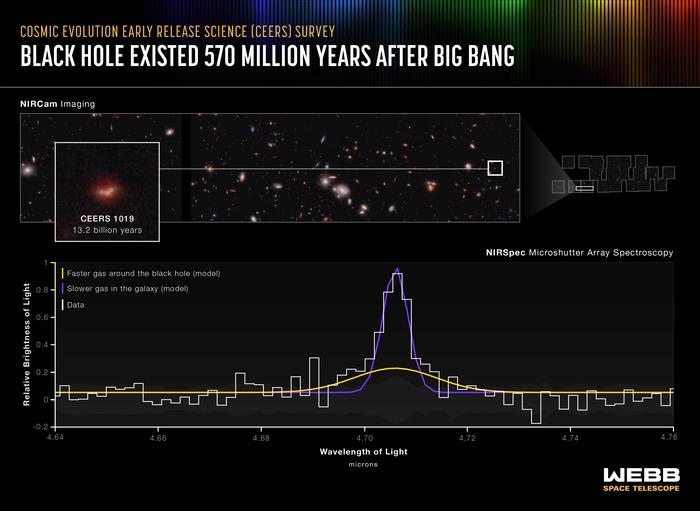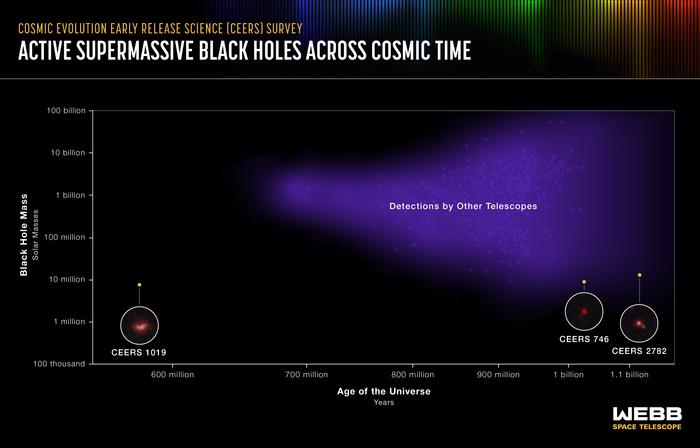Astronomers have announced the discovery of the most distant active supermassive black hole yet. The object is in a galaxy called CEERS 1019 and its light comes to us 570 million years after the Big Bang. It weighs much less than previously detected active supermassive black holes at very high distances from us – just 9 million solar masses.
This “light weight” object was announced in a series of papers that include other lightweight and active supermassive black holes: CEERS 2782 and CEERS 746. Their masses are all around 10 million times the mass of the Sun, huge by our standards but much smaller than the billion-solar-mass behemoths that we have discovered in the past. CEERS 2782 and CEERS 746 existed 1 billion and 1.1 billion years after the Big Bang. There are plenty of insights to be gathered from their signature lines in the emission spectrum.
These black holes would not have been visible without JWST, and the telescope was instrumental not only in discovering them but also in showing so much detail about their host galaxies, providing important details about the early universe.
“Looking at this distant object with this telescope is a lot like looking at data from black holes that exist in galaxies near our own,” lead author Rebecca Larson, recently at the University of Texas at Austin, said in a statement. “There are so many spectral lines to analyze!”

The image and spectrum of CEERS 1019.
Image credit: NASA, ESA, CSA, Leah Hustak (STScI)
The scientists were able to see that the host galaxy is pulling in a huge amount of gas while at the same time producing a lot of stars. Images of this galaxy did not look like a single point of light, as is often the case. Thanks to JWST, the team saw three bright clumps and not a simple circular disk.
“We’re not used to seeing so much structure in images at these distances,” said CEERS team member Jeyhan Kartaltepe, an associate professor of astronomy at the Rochester Institute of Technology in New York. “A galaxy merger could be partly responsible for fueling the activity in this galaxy’s black hole, and that could also lead to increased star formation.”

Comparison between the discovery of these three black holes and those by other telescopes.
Image credit: NASA, ESA, CSA, Leah Hustak (STScI).
These observations come from JWST’s Cosmic Evolution Early Release Science (CEERS) Survey and the data release also includes 11 galaxies among the furthest ever observed, whose light comes from between 470 million and 675 million years after the Big Bang.
The formation of supermassive black holes and their host galaxies in the early universe is an open question in astronomy. These observations are crucial to finally understanding that. And the presence of these lighter supermassive black holes implies that they might be commonplace.
“Researchers have long known that there must be lower mass black holes in the early universe,” team member Dale Kocevski, of Colby College in Waterville, Maine, added .“Now we think that lower mass black holes might be all over the place, waiting to be discovered.”
The work is published in several papers in a special edition of The Astrophysical Journal Letters.
Source Link: JWST Spots Most Distant Active Supermassive Black Hole Yet